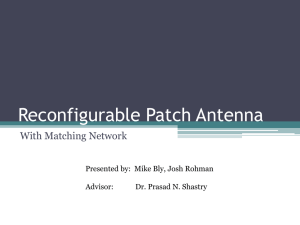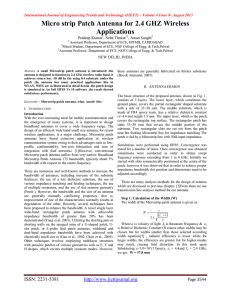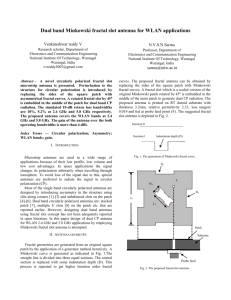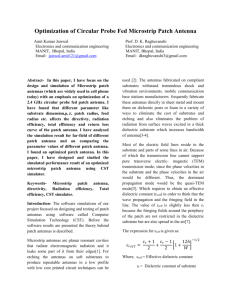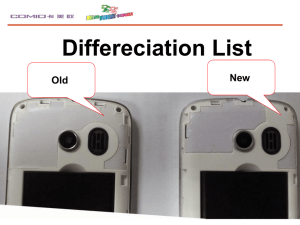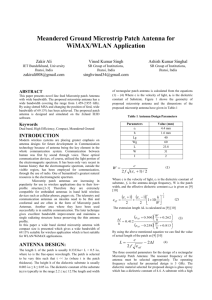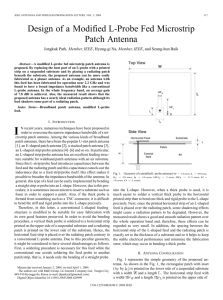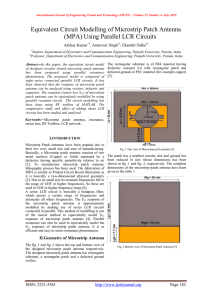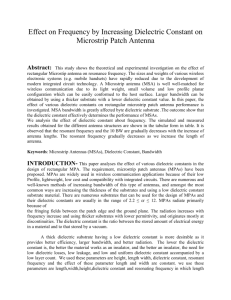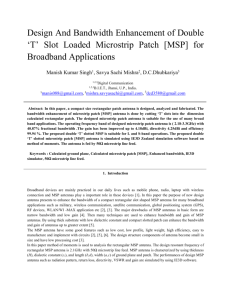Supplementary file
advertisement
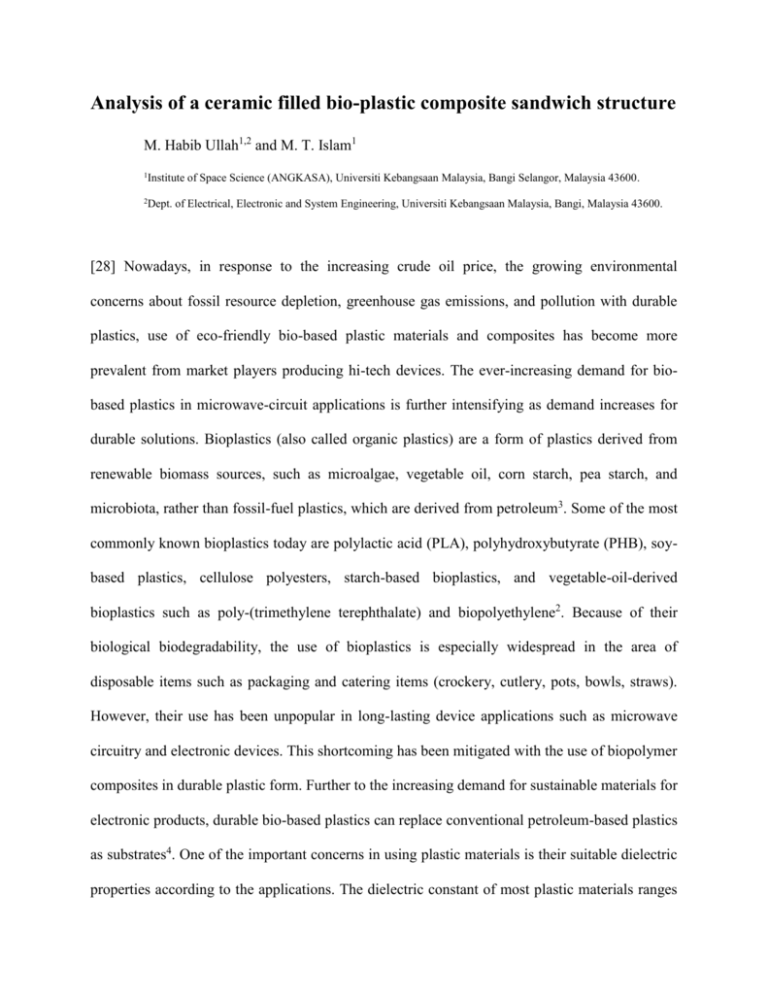
Analysis of a ceramic filled bio-plastic composite sandwich structure M. Habib Ullah1,2 and M. T. Islam1 1Institute 2Dept. of Space Science (ANGKASA), Universiti Kebangsaan Malaysia, Bangi Selangor, Malaysia 43600. of Electrical, Electronic and System Engineering, Universiti Kebangsaan Malaysia, Bangi, Malaysia 43600. [28] Nowadays, in response to the increasing crude oil price, the growing environmental concerns about fossil resource depletion, greenhouse gas emissions, and pollution with durable plastics, use of eco-friendly bio-based plastic materials and composites has become more prevalent from market players producing hi-tech devices. The ever-increasing demand for biobased plastics in microwave-circuit applications is further intensifying as demand increases for durable solutions. Bioplastics (also called organic plastics) are a form of plastics derived from renewable biomass sources, such as microalgae, vegetable oil, corn starch, pea starch, and microbiota, rather than fossil-fuel plastics, which are derived from petroleum3. Some of the most commonly known bioplastics today are polylactic acid (PLA), polyhydroxybutyrate (PHB), soybased plastics, cellulose polyesters, starch-based bioplastics, and vegetable-oil-derived bioplastics such as poly-(trimethylene terephthalate) and biopolyethylene2. Because of their biological biodegradability, the use of bioplastics is especially widespread in the area of disposable items such as packaging and catering items (crockery, cutlery, pots, bowls, straws). However, their use has been unpopular in long-lasting device applications such as microwave circuitry and electronic devices. This shortcoming has been mitigated with the use of biopolymer composites in durable plastic form. Further to the increasing demand for sustainable materials for electronic products, durable bio-based plastics can replace conventional petroleum-based plastics as substrates4. One of the important concerns in using plastic materials is their suitable dielectric properties according to the applications. The dielectric constant of most plastic materials ranges from two to five. High-dielectric substrate materials are necessary for miniaturized printed circuit board solutions. To highlight the importance of such substrates, miniaturization of printed patch antennas is one of the best examples5–7, although the impedance bandwidth of a patch antenna decreases for material substrates with high-dielectric constants. [29] A multilayer flexible antenna array based on organic material of a liquid crystal polymer was designed for dual-band applications and has achieved 1.17% and 4.46% measured operating bandwidths12. Miniaturized patch antennas based on ferrite/dielectric/ferrite magneto-dielectric sandwich substrates were proposed, achieving 74 MHz impedance bandwidth at a resonance frequency of 2.38 GHz13. A gain and bandwidth-enhanced microstrip line-fed patch antenna was designed and analyzed using a glass-silicon-glass sandwich substrate and obtained a bandwidth of 314 MHz and gain of 4.035 dB at 6.479 GHz11. A sandwich substrate-based microstrip patch antenna with a three-layered low-high-low dielectric constant was proposed and attained 46.9% for a 10-dB return-loss bandwidth and more than 5.2 for the directive gain14. [30] A 80 mm 78.4 mm star-shaped fractal patch antenna was used for miniaturization and backscattering radar cross-section reduction15. Although the fractal patch antenna achieved a 50% reduction in the overall size compared with a conventional circular microstrip patch antenna, operating bandwidths were poor. A circular-shaped fractal antenna with dimensions of 120 mm 120 mm for dual-band applications was proposed16. However, the antenna does not possess a compact profile compared with others proposed. A 50 mm 50 mm inscribed triangle in a non-concentric circular-shaped fractal antenna was designed for UWB applications17. [31] Designing of the proposed antenna focused on configuring its dimensions. The basic determination of the patch dimension is taken from the established mathematical formulation22: w L r 1 c 2 fo 2 c 2 fo r (1) - 2l (2) where W and L are the width and length of the patch, fo center resonance frequency, εr is the relative dielectric constant, Δl the increment to the length because of the fringe field, and c speed of light in a vacuum. Although the available mathematical modeling is based on the conventional rectangular patch for the proposed design, the overall dimensions are determined using a test and modify method. The effective dielectric constant εe can be calculated using23: e 1 1 10h ( r 1) ( r 1) (1 ) 2 2 W (3) where h is the thickness of the substrate. Because of the fringe field around the periphery of the patch, the antenna looks larger electrically than its physical dimensions. The increment Δl can be expressed as23:: w ( e 0.3) 0.8 h l 0.412h w ( e 0.258) 0.8 h (4) The fractal dimension can be determined using the mathematical formulation. Several methods have been studied such as topological dimension, Euclidean dimension, Tricot dimension, self-similarity dimension, and Hausdorff dimension24. However, the most easily understood definition is the self-similarity dimension. To obtain this value, the geometry is divided into scaled-down, but identical, copies of itself. If there are n such copies of the original geometry scaled down by a fraction, the similarity dimension D is defined as: D log n 1 log s (5) The proposed antenna is composed of a metallic circular patch configured of repetitions, up to three iterations, of periodically symmetric slots. The length of the flowing current over the fractal patch increases, which leads to multiple resonances and wider bandwidth. Fig. 1 shows the layout of the different iterations of the symetrically slotted fractal structure. One of the main parameters is the slot positions r1, r2, and r3 with respect to the center of the circle, which are determined using the following expression: r ri 1 i n n i 1 2 i 0, 1, 2,........, n (6) where n=3 is the number of iterations and r0=20 is the radius of the circle. From the above equation, r1=16 mm, r2=11 mm, and r3=5.5 mm can be calculated. FIG. 1. Configurations of (a) no slot, (b)one iteration, (c) 2 iterations and (d) 3 iteration of the parabolic slot for the proposed fractal geometric radiating patch. [32] A double-ridge guide horn antenna was used for reference with distance of 4 m between reference antenna and antenna under test. A photograph of the anechoic measurement chamber is given in Fig. 2. A pyramidal-shaped electrically thick foam absorber with less than -60 dB reflectivity at normal incidence was used on the wall, ceiling, and floor. A 1.2-m diameter turntable was used to rotate the measuring antenna at a 1-rpm rotation speed through a 360° rotation angle; the antenna was connected with 10-m cable to controllers. A vector network analyzer (VNA E8362C, Agilent Technologies) ranging up to 20 GHz was used for measurements. FIG. 2. Illustration of the anechoic measurement chamber. [33] FIG. 3: Smith chart of the proposed antenna
